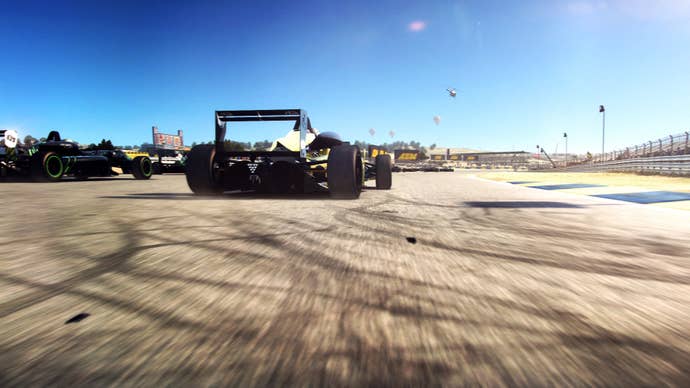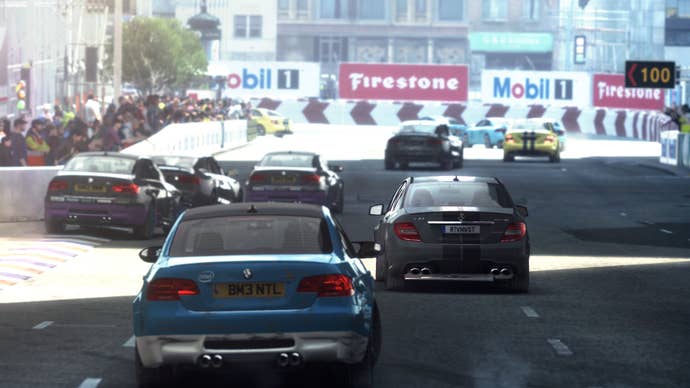GRID Autosport PS3 Review: Back in the Cockpit
Less a sequel to last year's GRID 2, and more a spiritual successor to its 2008 iteration, Race Driver: GRID, GRID Autosport brings back its cockpit view by popular request.
This article first appeared on USgamer, a partner publication of VG247. Some content, such as this article, has been migrated to VG247 for posterity after USgamer's closure - but it has not been edited or further vetted by the VG247 team.
I’ve played most of the TOCA and GRID games over the years, and have always enjoyed their more European-focused racing and heavy career modes, which help deliver a racing experience that’s unique to the series.

GRID Autosport continues this tradition, once again giving players the opportunity to become a racing personality with ambitions to become a driving champion. What’s immediately apparent this time around, however, is that GRID Autosport has dispensed with GRID 2’s rather more structured nature that essentially forced you to race in events that might not necessarily be something you were interested in. This time around, players are able to initially focus solely on the racing discipline of their choosing – something I most certainly appreciate. You do need to master them all to unlock GRID’s most advanced content, but the path you choose to reach it is your own.
There are five racing modes in all, Street, Tuner, Touring, Endurance and Open Wheel, and each offers an experience appreciably different from one another. I opted for Street racing, and after choosing my name and selecting an audio nickname from the huge roster of names on offer signed myself up for Team Oakley, thanks to their irresistible John Cooper Works racing Minis.

My first port of call was a San Francisco street track. While I wasn’t particularly impressed by GRID’s recreation of my home city’s downtown– it features most of the right landmarks, but just doesn’t capture the essence the place – I did enjoy the track itself. It’s a fairly technical course that features almost every type of corner and turn you can think of, making it really entertaining to race around.
I started at the back of the pack, and found myself having more than a few bumps, scrapes and crashes as I got used to GRID’s handling. Fortunately there’s a rewind button, and I used that repeatedly to un-crash myself so I could try different approaches to corners and overtaking maneuvers. It really does feel like cheating, and of course you can turn it off, but it is a really good way to get a feel for the game. And it’s especially useful since stuffing your car into a trackside barrier or rear-ending the person in front of you at high speed can result in catastrophic damage that’ll cost you the race.

GRID’s career structure is quite straightforward, and basically follows a sponsorship model where you need to hit specific objectives to attract new ones with deeper pockets. It’s a lot simpler and more rigid than past GRID games, and doesn't have any meaningful management or teammate decision-making, which makes the game sometimes feel a little arbitrary and lacking depth. It works fine, but it just doesn't do a particularly good job of making you feel invested in anything.
The most impressive aspect of GRID Autosport is its AI. There’s a distinctly organic feel about the way the cars are driven. They jockey for position, block intelligently, engage in daring overtaking maneuvers and even make quite convincing mistakes. It makes for close, believable and sometimes thrillingly competitive racing – an experience that’s certainly far more realistic than Gran Turismo’s AI, and it even gives Forza 5’s drivatar system a very good run for its money.

After racing Street, I moved over to Touring, and was again impressed at how the AI replicated the more nudge-and-bump style of this kind of racing. The Touring cars also felt distinctly different from the ones I raced in the Street series. They’re obviously more powerful, but they had a lighter and more direct steering feel. This is something I noticed as I moved from series to series – while GRID strikes a balance between simulation and arcade, its handling engine does a very effective job at convincingly articulating the characteristics of the different kinds of cars it features.

Speaking of cars, GRID’s roster of 78 feels a little meager compared to the likes of Gran Turismo, but what it lacks in number it makes up for in sheer variety. From hot hatches and hypercars to Le Mans and Indycar racers, GRID has a full spectrum of vehicles to choose from. While it might not have all the cars you desire, it certainly offers a wealth of different driving experiences.
And that’s what GRID is all about - racing variety. It’s a shame that the game’s career structure doesn’t have the sense of circumstance and excitement to make the single-player mode more compelling, but if you're the kind of person for whom racing is its own reward – particularly online – GRID Autosport still offers a terrific racing experience.

VisualsThe textures feel a little low-res and lacking in quality, but the overall impression of the game is good enough.
SoundThe engine sounds aren't particularly convincing, but like the graphics, they're good enough.
InterfaceGRID features a comprehensive set of options, and is thoughtfully structured.
Lasting AppealThe single-player mode packs plenty of challenge, and if you enjoy online racing, GRID's comprehensive multiplayer mode will keep you busy for as long as you want.
ConclusionGRID Autosport combines interesting cars, entertaining tracks, excellent AI, and a quality handling engine to deliver a terrific racing experience. Unfortunately its career mode lacks depth and isn't particularly engaging.








